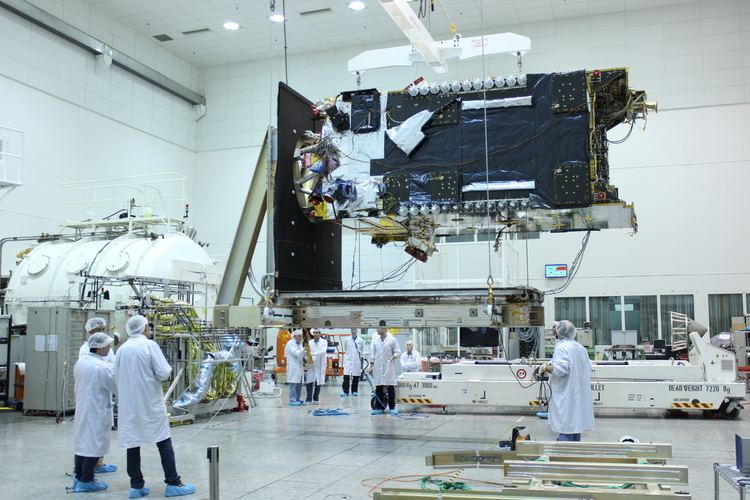Operator Spacecom Launch date Never launched. Launch mass 5,500 kg Rocket Falcon 9 Full Thrust | Power 10 kW Contractor SpaceX Launch mass 5,500 kg Bus AMOS | |
 | ||
Mission duration Planned: 15 years, Actual: None Disposal Fire in failed launch rehearsal test Manufacturer Israel Aerospace Industries Launch site Cape Canaveral Air Force Station Space Launch Complex 40 Similar JCSAT‑2B, Thaicom 8, Red Dragon, Dragon V2, Amos‑5 | ||
Spacex static fire anomaly amos 6 09 01 2016
Amos-6 was a 5.5-tonne Israeli Earth communications satellite, one of the Spacecom AMOS series, that was built by Israel Aerospace Industries (IAI), a defense and aerospace company.
Contents
- Spacex static fire anomaly amos 6 09 01 2016
- Terminology
- History
- Lease to external customers
- Destruction
- References
Amos-6 was intended to be launched on Flight 29 of a SpaceX Falcon 9 to geosynchronous transfer orbit on 3 September 2016. However, on 1 September 2016, during the run-up to a static fire test, there was an anomaly on the launch pad resulting in a fire and the loss of the vehicle and its payload, Amos-6. There were no injuries.
Terminology
Amos stands for "Affordable Modular Optimized Satellite" and is also an allusion to the prophet Amos. This spacecraft is the second implementation of the AMOS-4000 platform, the first was the Amos-4. It is one of a series of satellites built by Israel Aerospace Industries.
History
In January 2013, Spacecom announced that they had signed a contract with SpaceX for the 2015 launch of the Amos-6 satellite on a Falcon 9 launch vehicle. Amos-6 was intended to replace the Amos-2 satellite, planned to be retired in 2016. During 2015 Spacecom announced the launch date has slipped to mid-2016. A final launch date was set for 3 September 2016.
Under the deal with Spacecom, state-owned IAI, flagship of Israel's defense industry, was contracted to build Amos-6 and its ground control systems, as well as provide operating services. Spacecom estimated that the cost of launching, insuring and one year's operation of Amos 6 would be $85 million.
The Amos-6 included payload components from various sub-contractors including Canada's MacDonald, Dettwiler and Associates, which built the communications payload, and Thales Alenia Space ETCA for the electric propulsion. The satellite "[incorporated] new technologies that represent a significant leap forward in the capabilities of IAI and the state of Israel in space," according to IAI's president and chief executive, Joseph Weiss.
Lease to external customers
In October 2015, social media company Facebook and satellite fleet operator Eutelsat agreed to pay Spacecom $95 million over a period of about five years for the lease of the Ka-band spot-beam broadband capacity—36 regional spotbeams with a throughput of about 18 Gbit/s—on Amos-6 to provide service for Facebook’s Internet.org and a new Eutelsat subsidiary focusing on African businesses. Costs would be divided in approximately equal shares between Eutelsat and Facebook. The parties agreed to the right to terminate the contract if Amos-6 and the ground gateways in France, Italy and Israel were not ready for service by 1 January 2017. The lease was for the use of the satellite until September 2021, with an option for a two-year extension at a reduced rate.
After a technical analysis, including an assessment of customer power requirements, Facebook and Eutelsat concluded that only 18 out of the 36 Ka-band spot beams could be used simultaneously without sacrificing user experience.
Destruction
On 1 September 2016, the Falcon 9 launch vehicle suffered an anomaly during fuel loading for a routine static fire test that destroyed the vehicle and its AMOS-6 payload. The explosion started near the upper stage LOX (Liquid oxygen) tank. Because the satellite was destroyed prior to the launch, the cost of the satellite is not covered by Spacecom's insurance policy, but rather by the manufacturer, IAI. IAI has its own insurance, and will file a claim in order to compensate Spacecom. Spacecom's contract with SpaceX specifies Spacecom can choose to receive $50 million, or a future flight at no cost.
A number of serious theories as to the cause of the anomaly had been put forward by industry technical experts by mid-October. Most deal with issues in and around the carbon-fiber composite-overwrapped pressure vessel (COPV) that is used to hold the 34,000–38,000 kPa (5,000–5,500 psi)-helium tank that contains the pressurant used to provide LOX propellant tank pressure during launch. As of 16 October 2016, the formal accident investigation board has not yet released its findings. News reports in early November indicated that SpaceX has determined root cause for the anomaly, and that it is straightforwardly fixable, and that SpaceX will return to flight in December 2016. SpaceX CEO Elon Musk's comments on 4 November 2016 indicate that the propellant loading process appears to have allowed some of the liquid oxygen to turn to the solid phase, which reacted with the carbon in the carbon-fiber pressure vessel, resulting in the deflagration. On 2 January 2017, SpaceX released an official statement indicating that the cause of the failure was a buckled liner in several of the COPV tanks, causing perforations that allowed liquid and solid oxygen to accumulate underneath the lining, which was ignited by friction.
